PROVINCETOWN — The reds and greens of flags and scarves and the percussive sounds of drums and ratchets that accompanied the Provincetown Portuguese Festival all weekend brightened a foggy, windy Sunday for the procession and the Blessing of the Fleet. This year was the 77th celebration of the blessing and the 28th festival. Photographers Elizabeth G. Brooke and Agata Storer were there and each offers her own point of view on the celebration. Here, Brooke captures the festival’s colors on Commercial Street and Lopes Square.
Blessing of the Fleet
LEAPS AND BOUNDS
Young People Revel in the Blessings of the Day
PROVINCETOWN — MacMillan Pier was busy on the misty morning of the Blessing of the Fleet on Sunday as our family rushed past the twirling skirts of dancers in Lopes Square to gather on Capt. Damian Parkington’s F/V Clean Sweep. Waiting for the rest of the guests to arrive, teenagers passed the time fishing. Jacob Parkington caught a tautog, while other boys picked up mussels stuck to the wooden poles of the pier, using them as bait after smashing them on the boat’s deck. Then, as the boats lined up for blessings from Bishop da Cunha, the kids settled in to get the best views. Later, boats anchored, they leapt into the water, climbed aboard, and leapt again. —Agata Storer
[

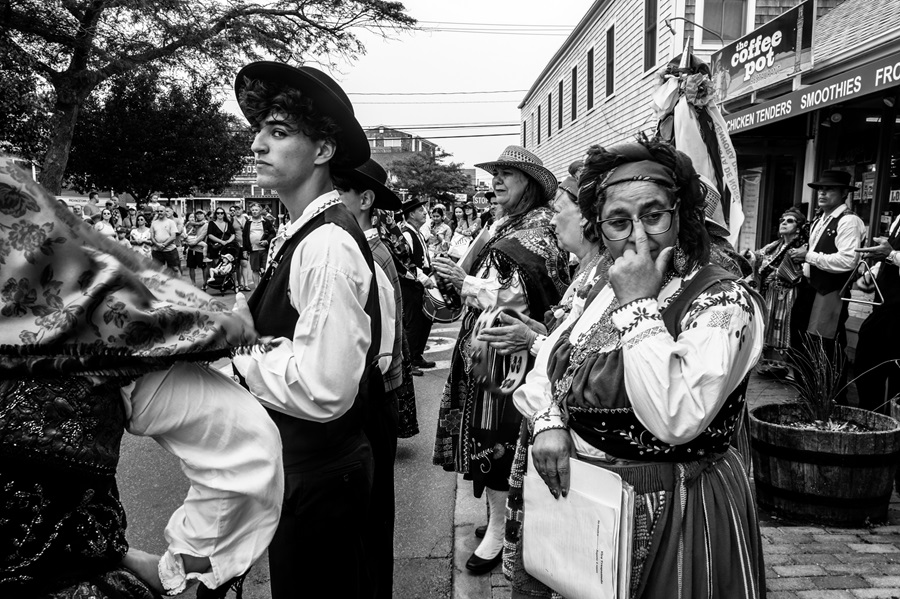
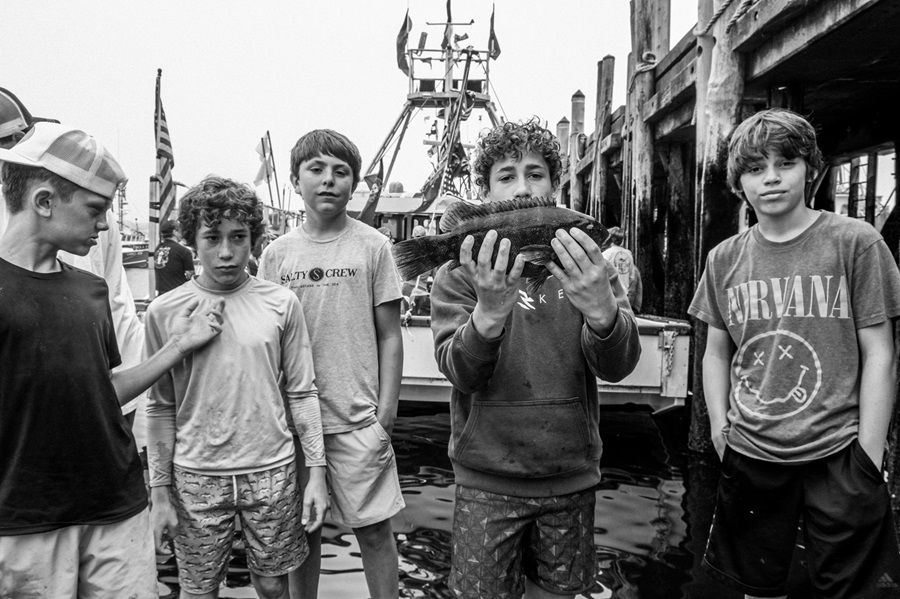
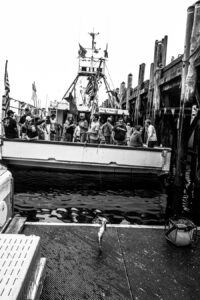
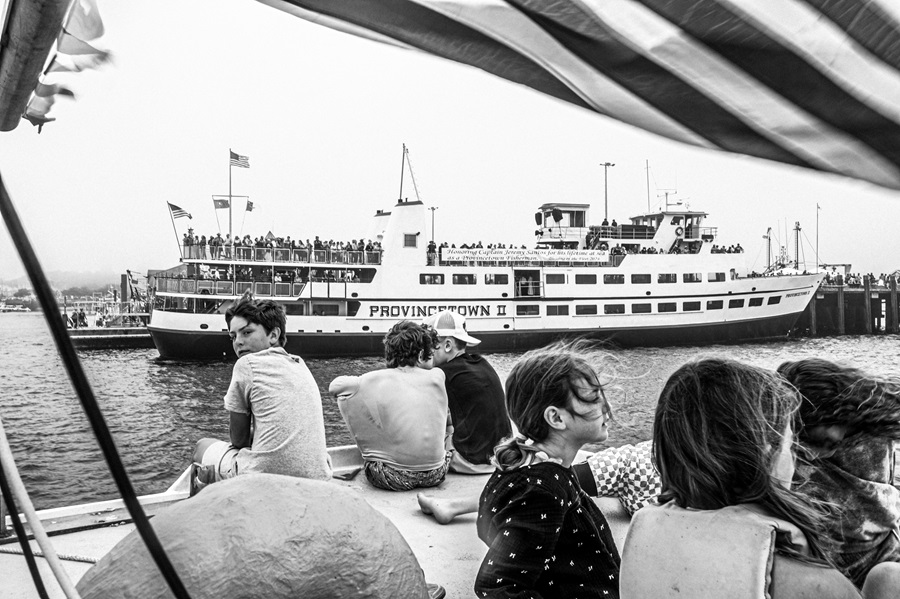
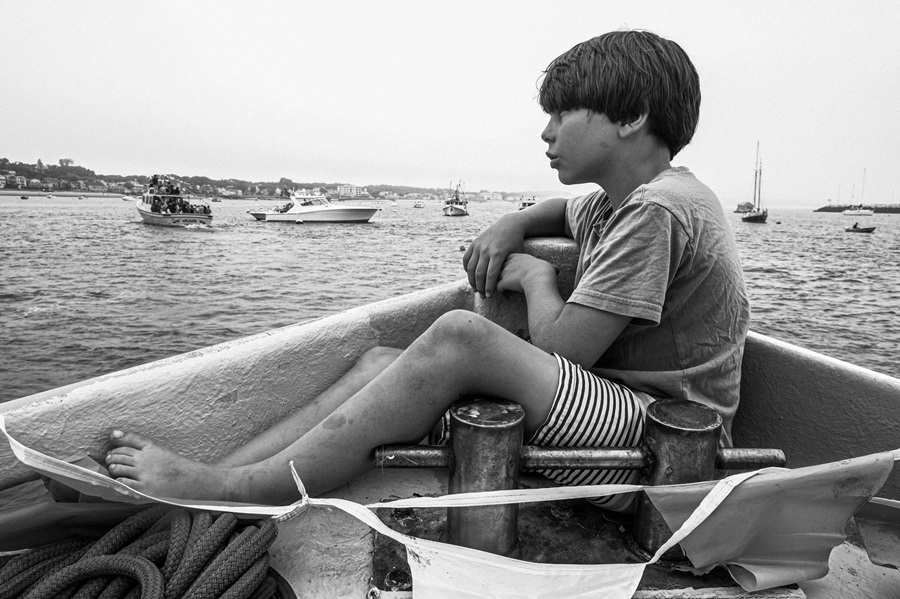
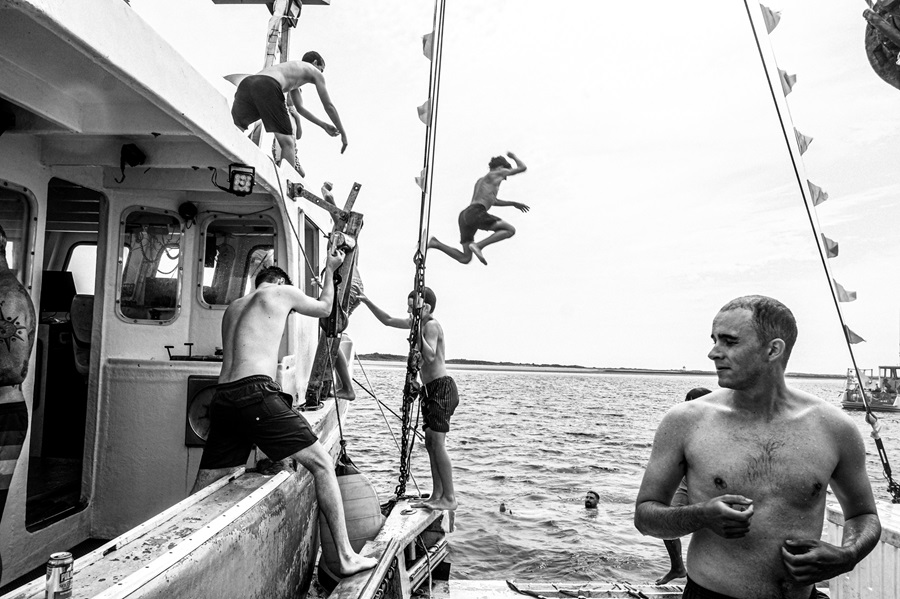
BLESSING OF THE FLEET
Lifting Up the Patron Saint of Netmakers, Shipbuilders, and Fishermen
Alex Brown and Nancy Silva talk about St. Peter and processions past and present
PROVINCETOWN — The 28th Provincetown Portuguese Festival begins Friday, June 28 with live music and dancing in Portuguese Square on Ryder Street. During the three-day-long celebration, there will be a fishing derby on MacMillan Pier named for Capt. Kenny Silva, fishermen will tell stories on Ryder Street where there will also be a crafts fair and poetry, and the Knights of Columbus will hold a soup tasting under a tent at the Bas Relief Park behind Provincetown Town Hall. There will be accordions, samba baterias, and fado.
But for at least some people, none of this will compare to the event happening for the 77th time, the Blessing of the Fleet at MacMillan Pier. “Everyone confuses the festival for the blessing,” says Provincetown fisherman Alex Brown. “The festival leads into the blessing, but the blessing is a separate event — it’s always the last Sunday of the month.”
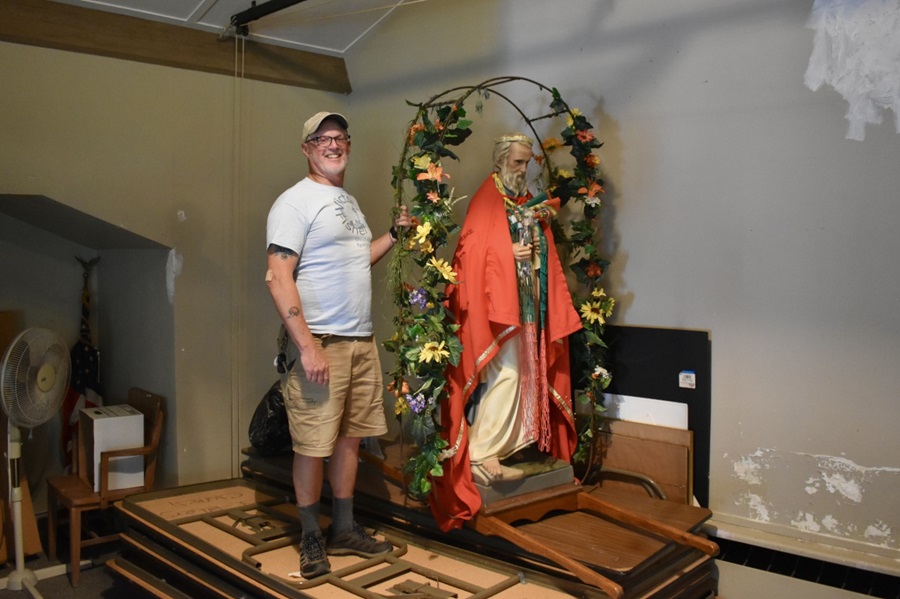
That Sunday starts with a Fishermen’s Mass at St. Peter the Apostle Catholic Church. From there, a group of fishermen (this year, so far, that’s looking like Brown, Christian Costa, and Chris King) carry a statue of St. Peter — the patron saint of netmakers, shipbuilders, and fishermen — down to the pier for the blessing, a ritual meant to ensure a safe and bountiful fishing season.
It’s the week before the blessing and Brown and Nancy Silva just got out of Mass at St. Peter’s. They are backstage in the parish hall standing next to the statue of the saint. Silva grew up in Provincetown. She photographed the festival for years before signing up to help organize in 2019. Now she’s responsible for creating its history-filled booklet. Brown, who wears his company’s gray Victory Fisheries T-shirt and a tan baseball cap, retired from lobstering in 2019 but continues to work his shellfishing grant in Provincetown, which he’s being doing for the last 35 years.
They run through their memories of men who have carried the statue of St. Peter. They can’t agree on which year Chris’s son, Jared, did it and when Brandon Motta carried it.
The church’s St. Peter is six feet tall. He stands under an eight-foot trellis and wears a red robe draped with a green-and-red fishing net with dollar bills tucked into it. “People tuck money into his netting in honor of someone who has passed,” Silva says. Peter grips an elaborate silver key in his enormous, angular right hand and tilts his golden crown downward a touch. He has the slightly possessed gaze of someone on a mission.
“These fishermen — what a dangerous, hard life they had,” says Silva. “They didn’t have GPS, they didn’t have radar — they just went out.” Silva remembers stories of fishermen who went out on schooners, then fished from dories. “Sometimes those dories never came back to that mother ship,” she says. “I grew up here in a fishing family, but we didn’t think of it. Fishing is what you did: you went out to fish and then you had dinner.”
In 1996 a group added the Portuguese Festival to the Blessing of the Fleet. “That’s when everything was beginning to fall apart,” Silva says. “They’d had the blessing since 1947, but the fishing feet was declining.” There had to be another way to recognize the town’s Portuguese fishing heritage.
Brown has been carrying the statue of St. Peter every year since the festival started. He remembers the weight of the original wooden statue. Training was minimal, he says: “Kenny Macara said, ‘OK, kids, your turn.’ ”
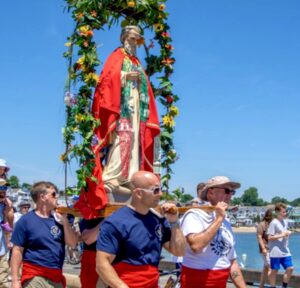
The statue weighed over 500 pounds, Brown says. The Portuguese consul came over and tried to lift the statue. When he couldn’t, he promised to bring a lighter statue. “Yes, they stayed with us at the motel in Truro,” says Silva, remembering the whole entourage coming to the Top Mast, her North Truro place.
The new statue, made of polystyrene, is not that much lighter, Brown says. Carrying the saint can be awkward, he adds: “Last year I couldn’t get people and we almost dropped him on the altar.”
“We could put him in a golf cart,” says Silva. “We could decorate it and you could walk alongside it,” she says to Brown.
The original route for carrying the statue from the church to the pier was: “Left out of the church; down Bradford Street; right on Johnson Street past the library; right on Commercial Street; and a left at Lopes Square towards the wharf,” says Brown. “That’s the way we used to do it.”
The route changes from time to time, depending on public works and construction projects and street repairs. The main thing, Brown says, is “trying to avoid going down that hill,” he says.
“So steep,” says Silva.
“Those crosswalks — they’re slippery,” says Brown.
When they get to the corner of the hill they “crab it a little,” Brown says. “I always tell everybody, ‘One step at a time — you don’t want to fall.’ ”
For the last few years, the carriers have taken St. Peter down the Bradford Hill and taken a right on Gosnold Street and a left on Commercial Street to the pier, which will likely be the route this year.
When St. Peter’s Church burned down in January 2005, the Mass before the blessing was held at the marina on Fisherman’s Wharf. “Bobby Cabral owned it at the time,” says Brown. “They set up the church with all the chairs inside Cabral’s big fish house.”
“The Mass that year was one to remember,” says Silva. “Boats were going by; the priests had their backs to the fishing vessels.” Come to think of it, Silva adds, “We should have it there every year. They haven’t done anything with that building yet.”
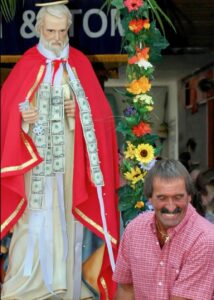
The marina’s new owners, Chuck and Ann Lagasse, who live in Charlestown, told the Independent in April that the public walkway they promised the town they’d build in 2017 will be ready next spring.
The blessing was at Fisherman’s Wharf for two years. The second year, Brown remembers, it was pouring, and it was windy. Before they set out to carry the saint to the Carol Anne, “I said I’m not putting St. Peter out in this.” There was no procession that year.
“The procession is not just St. Peter — it’s all the families who carry the banners with the names of their fishing vessels,” says Silva.
“The bishop blesses St. Peter and all the banners,” says Brown.
“It’s Bishop da Cunha from the diocese of Fall River. He’s been coming the last five years,” says Silva. “What happens is that St. Peter gets taken to the pier and put on the lead boat for the procession. This year it will be the Glutton, which belongs to Beau and Kathleen Gribbin.” Beau came to the parish hall to measure so he could build a platform on his boat to make St. Peter more visible, Silva says.
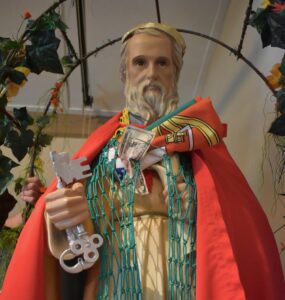
“On Chris King’s boat, the Donna Marie, we put him on the pilot house,” says Brown. King, he says, was born in Provincetown and has been fishing since boyhood. He owns Cape Tip Seafood. His father, Capt. William W. King, was lost with his crew of six when the Patricia Marie sank off Eastham in 1976.
“Chris has tried to bring the fishermen back into it more,” says Silva. “So many fishermen are gone. There are a lot of pleasure boats for the blessing, and kayaks now.”
“The draggers don’t want to drive into those people,” says Brown.
Some 100 volunteers work on the festival and coordinate details for the blessing, according to the festival website.
“A lot of these people have spent 25 to 30 years doing this,” says Silva. “The younger people hang the flags. It’s nice to see them involved.” Heather of the Stop & Shop flower dept. makes a crown of flowers for St. Peter and Provincetown’s Michael Lussier attaches it to the arch over the saint. The flowers are donated by Stop & Shop.
“Bishop da Cunha is wonderful; he loves to come for the blessing,” says Silva. “He eats at the Lobster Pot afterwards.”
Editor’s note: An earlier version of this article, published in print on June 27, incorrectly reported that Capt. Kenny Silva would be leading the fishing derby that is named for him. St. Peter’s crown of flowers was made by Heather of the Stop & Stop flower dept., not by Michael Lussier, who attached it to the arch.
PORTUGUESE FESTIVAL
This Fleet Is Blessed
On a glorious day, a quiet ritual
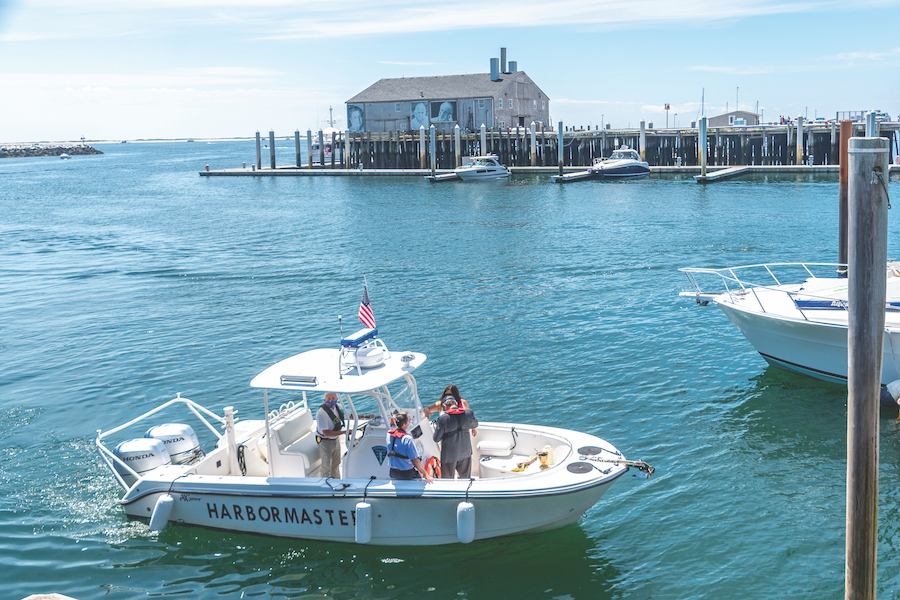
The harbormaster’s launch returns to the pier on Sunday after a sunny midmorning on the rounds with the Rev. Hugh McCullough, affectionately known as Father Mick. Though the event was purposefully quiet this year, because the coronavirus calls for avoiding crowds, the annual Blessing of the Fleet was no less sacred for it.
“It does not start with a parade of boats,” Susan Avellar of the Portuguese Festival committee wrote in an email to the Independent. “It starts in the heart and at the church.”
On board with Father Mick are Minister Leeanne Nelson and Deacon Alan Thadeu, who joined in from churches in Fall River. Guiding the boat in is Don German, Provincetown’s acting harbormaster. (Photos Nancy Bloom)
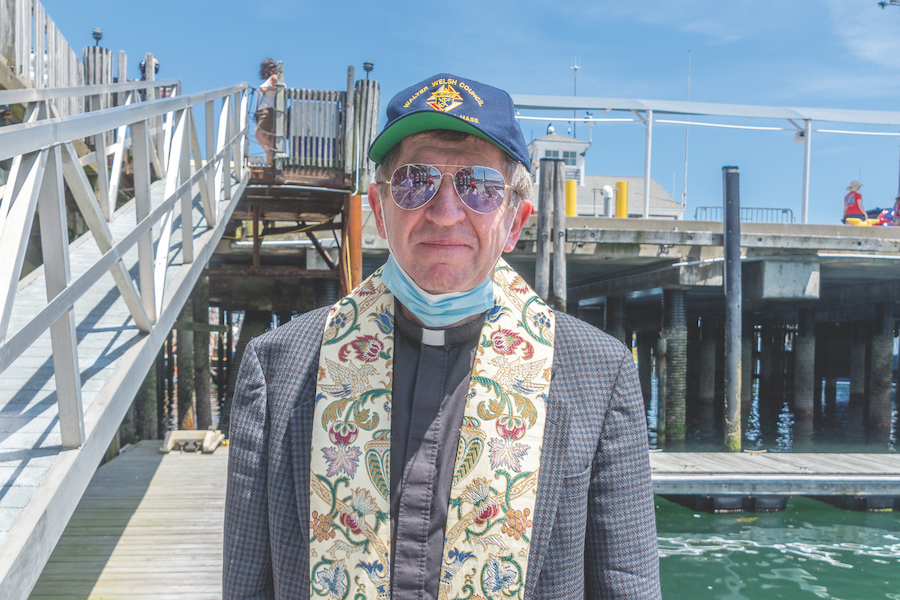
Father Mick, the pastor at St. Peter the Apostle Catholic Church in Provincetown as well as Our Lady of Lourdes in Wellfleet, gave the boats their blessing. “God bless this vessel and all those who work upon it,” were his straight-to-the-point words.
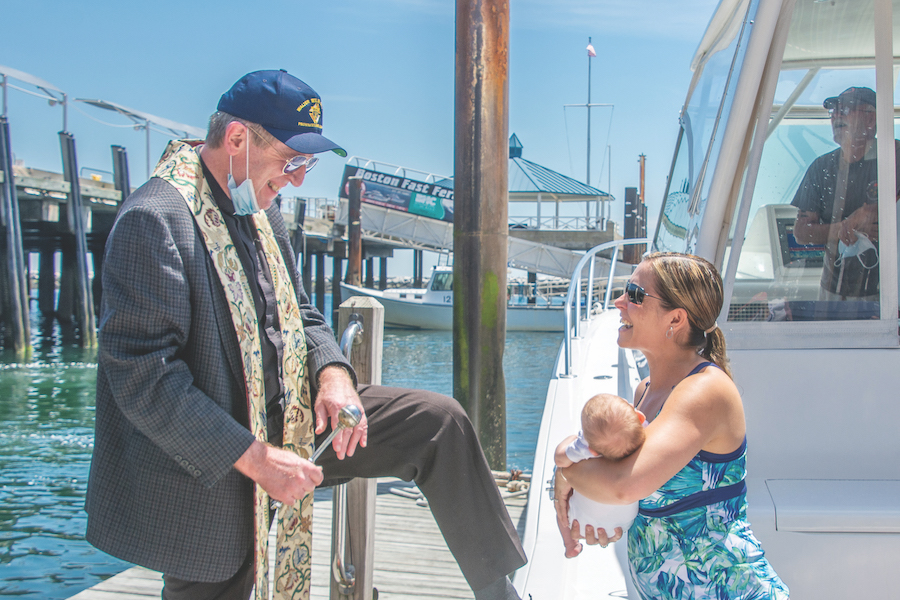
A chance encounter on the way home led to an unexpected extra blessing. Here is seven-week-old Zane Burhoe, the newest arrival in a long line of fishing families, who set out on his first boat trip with his mom, Laura, and, in the background, his grandfather, Richard Burhoe of Truro, at the helm.
ELEMENTS OF STYLE
Rite of Passage: Hawthorne’s ‘His First Voyage’
The painting honors the spirit of the 73rd Blessing of the Fleet
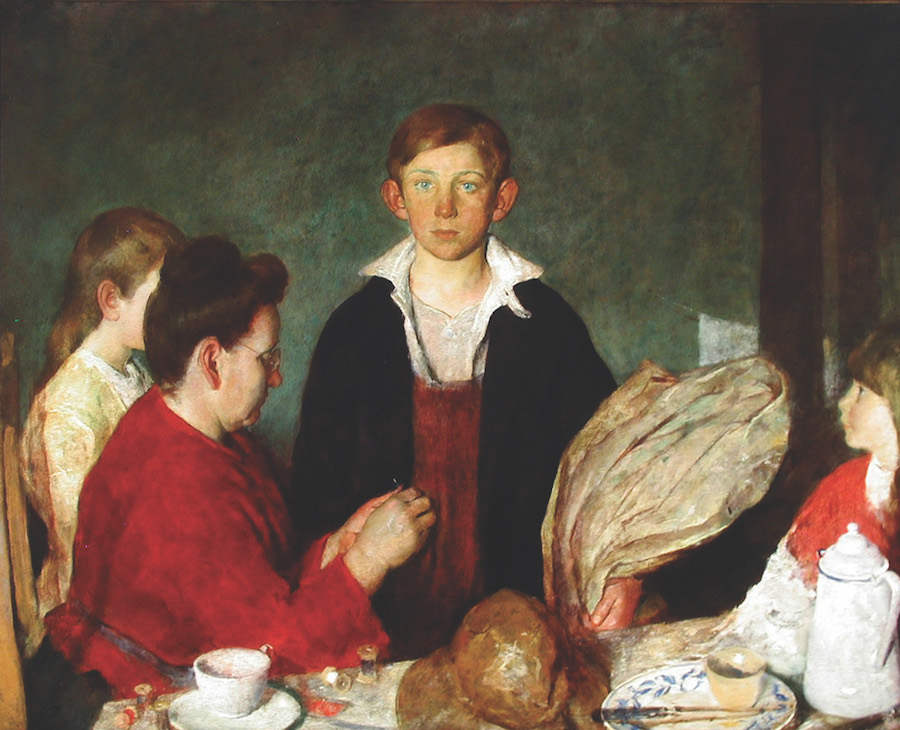
At four by five feet, His First Voyage, by Charles Webster Hawthorne, is an imposing painting. Its figures are roughly life-size. The subject is, seemingly, just a domestic scene. A boy is surrounded by his sisters and mother, the table laid with the makings of afternoon tea. The title, however, reveals something weightier: the boy is about to embark on his first sea voyage, which could potentially be perilous and harrowing.
Hawthorne is famous for founding the Cape Cod School of Art in 1899 in Provincetown. He taught numerous memorable pupils, including Edwin Dickinson, Henry Hensche, and Lucy L’Engle. Many of Hawthorne’s paintings, which take inspiration from the Portuguese fishing community in Provincetown, focus on the internal psychology of the characters.
His First Voyage was painted in 1915, one year after the founding of the Provincetown Art Association (and, later, Museum, or PAAM), which Hawthorne served as honorary vice president. The painting is one of the celebrated masterworks of PAAM’s permanent collection, a gift of Charles’s son, Joseph, in 1949. It is frequently hung in exhibits from the collection but is currently in storage.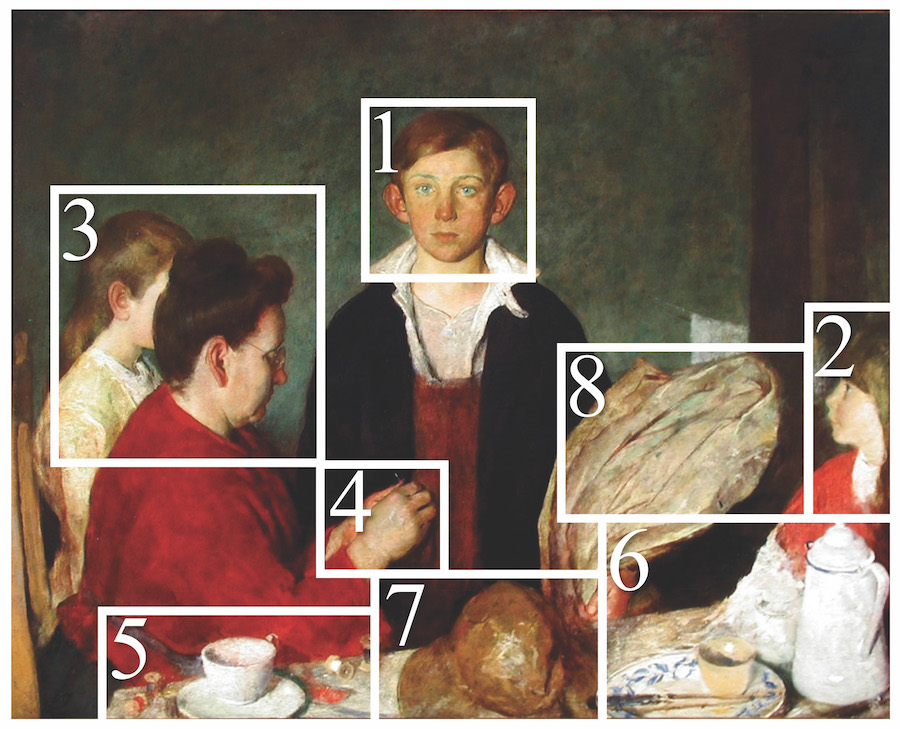
- That Face
Looking at the painting, you are instantly drawn to the central figure’s luminous, pale blue eyes. His expression is difficult to parse. Is he sad? Scared? Courageous? Stunned? He appears to be on the brink of adolescence. His complexion is ruddy, and he has a swath of red hair.
His ears stick out in the way that boys’ ears sometimes do, as if he hasn’t yet grown into them. One can see Hawthorne’s influence on Norman Rockwell, briefly his student, in his depictions of gangly adolescents. The boy’s youthful appearance reinforces the undercurrent of the painting: the impending voyage is his coming-of-age.
But who is the model? According to a 1999 article in the Provincetown Advocate, it is 13-year-old Jacob Smith, a local boy who worked in the lumberyard. Neither Portuguese (suggested by his red hair) nor from a fishing family, Jacob is instead acting the part in a story all too familiar for Provincetown.
- Watching Big Brother
The little girl on the right was modeled by Jacob’s youngest sister, Fannie. She was eight years old at the time and recalled modeling for Hawthorne in the Advocate (she died in 2001). Shown in profile, she is the only figure other than Jacob for whom a white glint of eye is visible. She seems to be looking up at her brother in admiration.
- Portuguese Pedigree
The figure on the far left was modeled by Nellie, Jacob’s other sister. Her face is hidden by Clara Smith, Jacob’s mother.
Descendants of the Smith family still live in Provincetown. In fact, Lilli Osowski, who was profiled for her work with veterans in the May 21 issue of the Independent, is Jacob Smith’s great-great-granddaughter. Although the Smith family was not Portuguese, many of its descendants are now Portuguese through marriage.
- A Needle Pulling Thread
The mother in the painting wears spectacles in order to sew a button on the boy’s jacket. The glint of a silver needle is visible in front of the dark fabric. Hawthorne plays with his characters’ gazes — Nellie’s is hidden, Clara’s is focused on sewing, Fannie’s is at her brother, and Jacob’s is directly at Hawthorne … or us.
5 & 6. Nature Morte
The table is covered with spools of thread from the mother’s sewing. They are the colors that make up the painting: black, white, and red.
The tableau also includes a cup and saucer, plate and knife, coffee pot and sugar bowl. Richard Mühlberger, in his book Charles Webster Hawthorne: Paintings & Watercolors, says that these items are “all symbolic of parting.”
- Hats Off
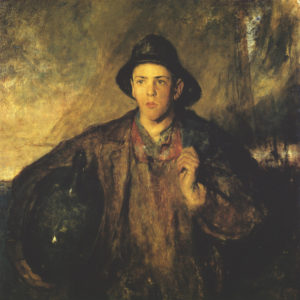
The Fisher Boy, another painting by Charles Webster Hawthorne in the New Britain Museum of Art, shows how an oilskin hat is worn by fishermen. (Photo New Britain Museum of American Art)
Also on the table is a fisherman’s oilskin hat. Compare this hat to the one in The Fisher Boy (on this page), which Hawthorne painted seven years earlier. These hats were made from waterproof oiled canvas — revealed by the way Hawthorne has painted the light on it — and were longer in the back to prevent water from trickling into the fishermen’s coats.
- Danger at Sea
The boy is also holding an oilskin coat. One can tell that the coat is stiff from the way he holds it. He is dressed very warmly: waterproof coat and hat, jacket, apron, shirt, and undershirt. It is blisteringly cold on the high seas.
While Hawthorne’s scene may not be modeled by an actual Portuguese fishing family, it tells a story rooted in truth. According to Mühlberger, by the time Hawthorne arrived in Provincetown in 1898, there were over 1,000 recorded shipwrecks off Cape Cod. The perils associated with fishing lend special significance to the painting, and to the boy’s poignant expression.
These dangers are precisely the reason why the Blessing of the Fleet came to be: to pray for the safe passage of fishermen, young and old, into unknown waters.
